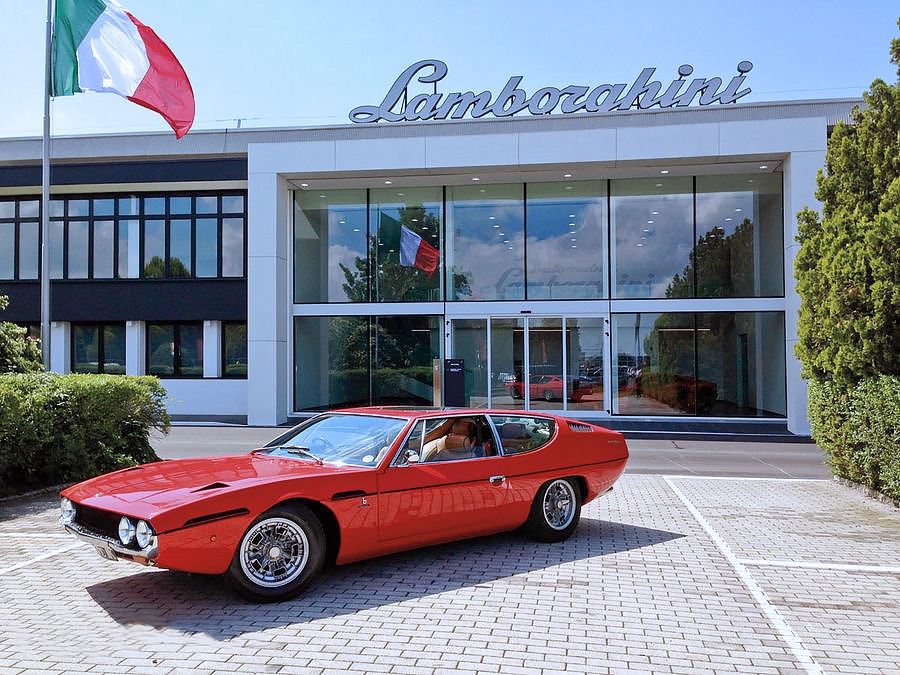
Family Flyer. Espada: Lamborghini’s foremost V12 powered Four-Seater. By James Dietzler and Mark J. McCourt. Photography by James Dietzler. The Espada’s predominantly horizontal styling is unusual and distinctive, and the low roofline belies the room inside.
How many full-blooded exotic Italian V12 GTs can thunder around a track at 150 mph and play practical grocery getter, all for a price less than a new Volkswagen Passat?
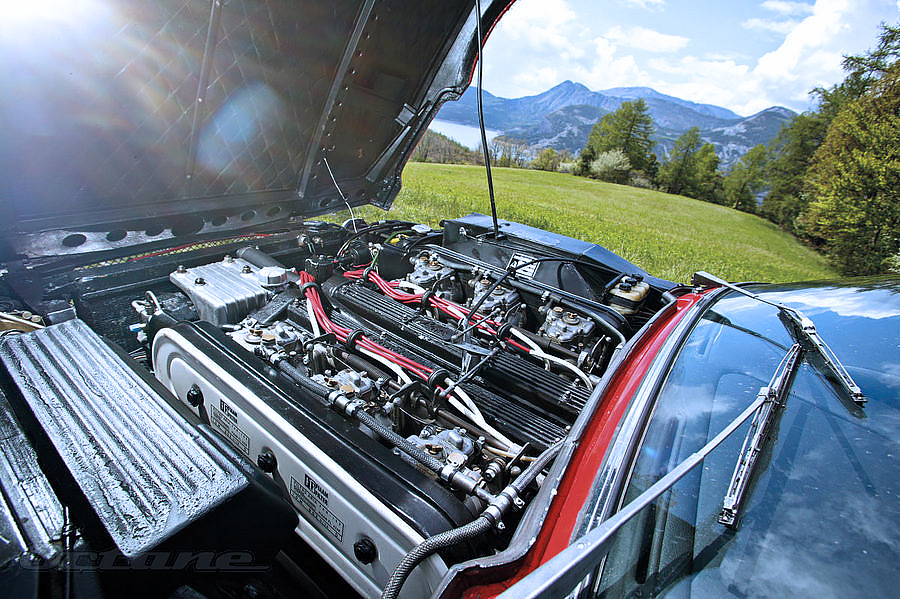
Top into the sweet spot of the V12’s powerband, and a sonorous combination of mechanical clatter and rising exhaust tones pulses through the cabin. Whip antenna is mounted atop windshield.
Okay, so it requires a strong clutch leg and loads of patience to operate the five-speed gearbox in traffic, and its low stance means its roof will fall below the sight line of most of today’s high-saddle SUVs. But the trunk space under the rear glass is a usable 10.4 cubic feet, and outward visibility is very good in nearly every direction, helped by the characteristic vertical rear panel above the license plate. Welcome to Lamborghini’s Espada.

In 1967, the Italian design firm of Bertone produced a futuristic concept car called the Marzal for the Geneva show. The show car’s lengthened chassis was based on that of Lamborghini’s exotic transverse V12-engined two-seat sports car, the Miura. The Marzal was powered by a 1,965cc overhead-cam V6, effectively half a Miura engine. It sported a long-roof fastback with a broad, flat hood, low-profile headlamps, and a mid-belt character line that encircled the car. The most expressive aspect of the design was the doors: Massive gullwing portals had glass-filled roofs and sides with glass above and below the beltline split. The effect was a feeling of exposure, like sitting in a fishbowl — and Ferruccio Lamborghini, the company’s namesake, deemed it too much.
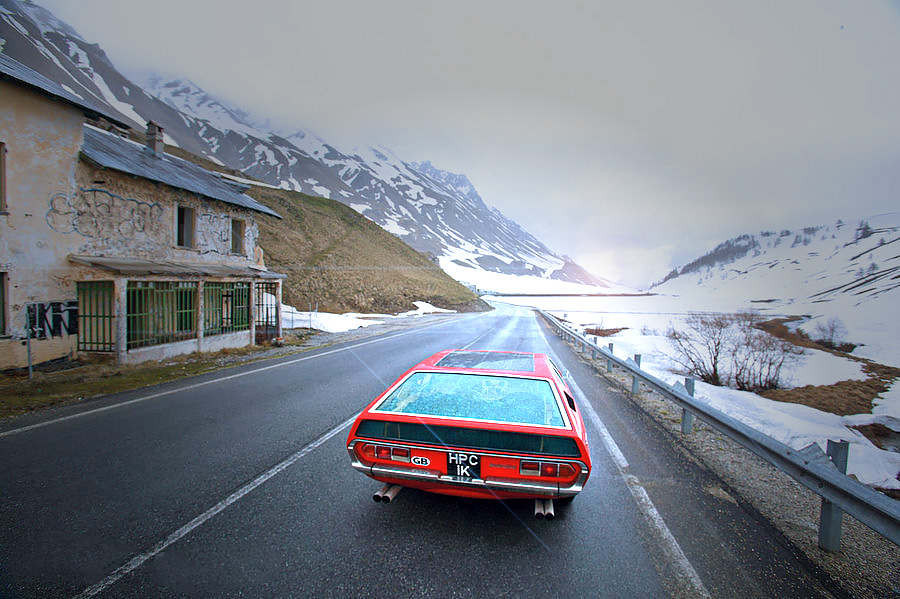
A front-engine V12 prototype that had more understated styling but retained the gullwing doors was built shortly after the show car. This car lost the glass in the bottom and roof of the doors, but kept small main window vents similar to those on the Subaru SVX and an odd crescent-shaped window in the C-pillar. The prototype also had very large front fender air vents, wide taillamps, and its rear hatch ended in a curve.
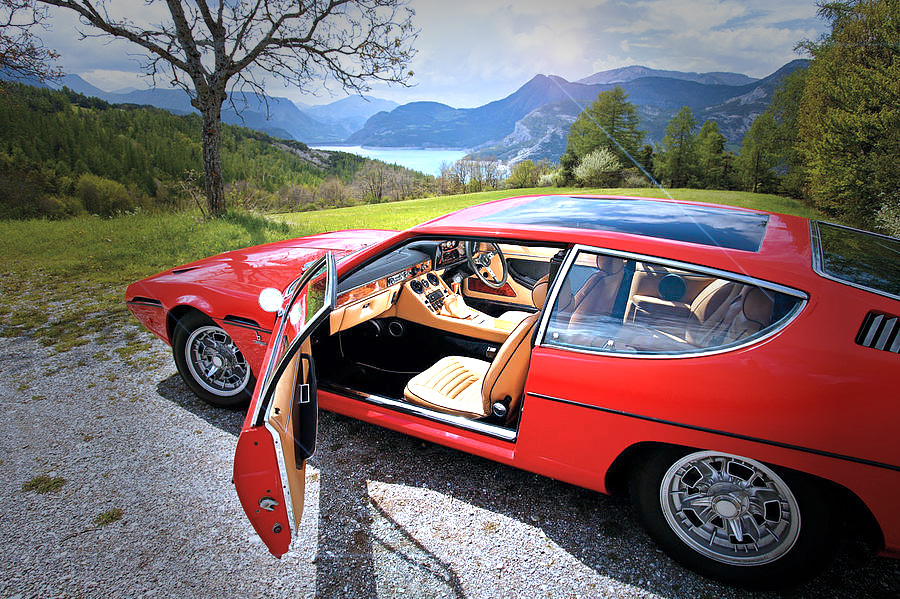
Magnesium aluminum wheels are very rare. Nameplate expresses bullfighting sword. Hood vents incorporated into body seam. Ansa mufflers sound good, but rot fast. Glass panel provides good rear visibility. Interior door panels are strangely plain. Comfy bucket seats are swathed in leather. Dual ignition coils, one per distributor. Back seats suit adults well for short trips.
Bertone continued this styling theme when it premiered its Piranha concept at the 1967 Earl’s Court show. The Piranha added a gracefully upswept rear quarter window, conventional doors, and a generally more voluptuous form to the basic Marzal shape. This car was built as a styling exercise on a Jaguar E-Type platform, and it appealed to Mr. Lamborghini greatly; the Piranha was the direct inspiration for the production Espada.
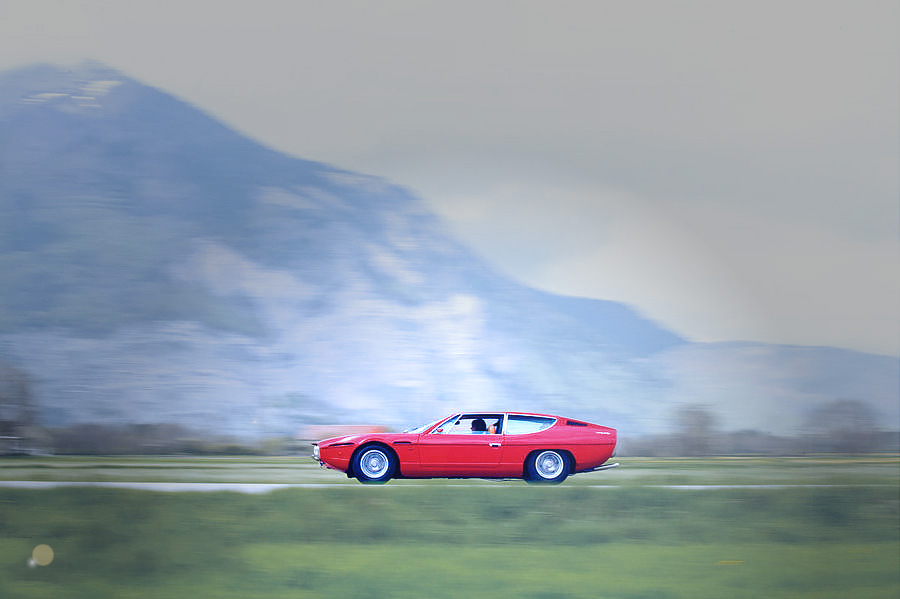
Chief designer Marcello Gandini took this general form and tweaked the details, adding small fender vents for engine cooling, NACA hood ducts for cabin ventilation, and a unique transparent vertical rear panel for visibility. In the process, Lamborghini received a comfortable — dare I say practical? — four-seat GT with V12 performance that a whole (wealthy) family could enjoy.
‘Named after a bull-fighting sword, the Espada was introduced in 1968 as Lamborghini’s largest GT. ’
Named after a bull-fighting sword, the Espada was introduced in 1968 as Lamborghini’s largest GT. The car’s pressed-steel platform chassis was joined to the steel body and forward-tilting one-piece aluminum hood, offering a rigid structure. The suspension; drivetrain; and aluminum quad-cam, 3,929cc V12, with six two-barrel, 40mm Weber DCOE carburetors were all taken from the two-plus-two Lamborghini Islero. With a 9.5:1 compression ratio, the new car made 325hp and 276 ft.-lbs. of torque. The Espada also borrowed the Miura’s center-lock Campagnolo alloy wheels. In the first two years of production, the car was considered a Series I, and unique features included a hexagonal dashboard layout, thin chrome bumpers front and rear, and slats on the vertical rear window. These cars listed for $21,000, and a mere 186 were built before the Series II was introduced.
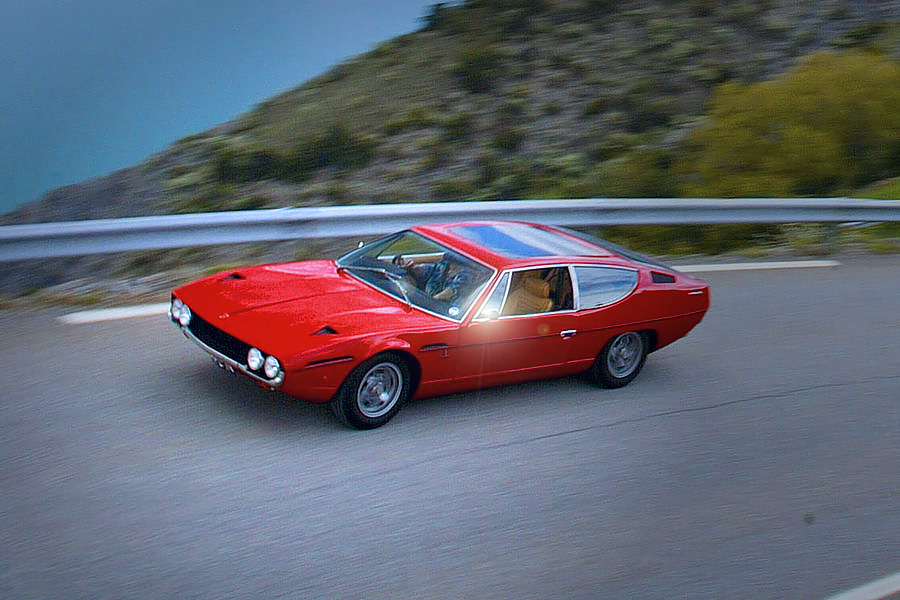
Each bank of triple Weber sidedraft carburetors utilizes a large single air filter element. Looking like it was squashed by Godzilla, the Espada’s shape, especially when viewed from the rear, is highly individualistic. View of the rear lower glass panel looking through the interior rear-view mirror.
In 1970, the Espada’s second series debuted. The new cars produced 350bhp and 290 ft.-lbs. of torque, accomplished with a bump in compression to 10.7:1. Conventional five-bolt alloy wheels replaced the previous knock-offs, and the four-wheel disc brakes were vented. A redesigned rectangular dashboard trimmed in wood lay behind a steering wheel with optional power assist to lessen driver fatigue, and a new console between the rear-seat passengers made traveling back there more comfortable. Lamborghini built 575 Espada Series IIs, at a reduced price of $19,500.
The third and final series of Espadas arrived in late 1972, and these cars contained changes that would last through the end of production. A minor restyle front and rear denoted Series III cars, as did new dashboards that wrapped around the driver to touch the nearly vertical console stack. Altered spring and shock damping rates helped the cars ride, and air conditioning was made standard equipment. New options included a sunroof and a Chrysler-sourced TorqueFlite three-speed automatic trans-mission, neither of which are fitted to our drive Report car. In the mid-1970s, changing regulations for the U.S. market required Lamborghini to fit five-mile-per-hour bumpers and a special emissions control smog pump that shut down at high rpm to preserve power. By 1974, the Espada’s price was substantially raised, to $33,900, and it was showing its age by the time production ended in 1978. Total Espada production was 1,217 vehicles; 456 of them were Series Ills.
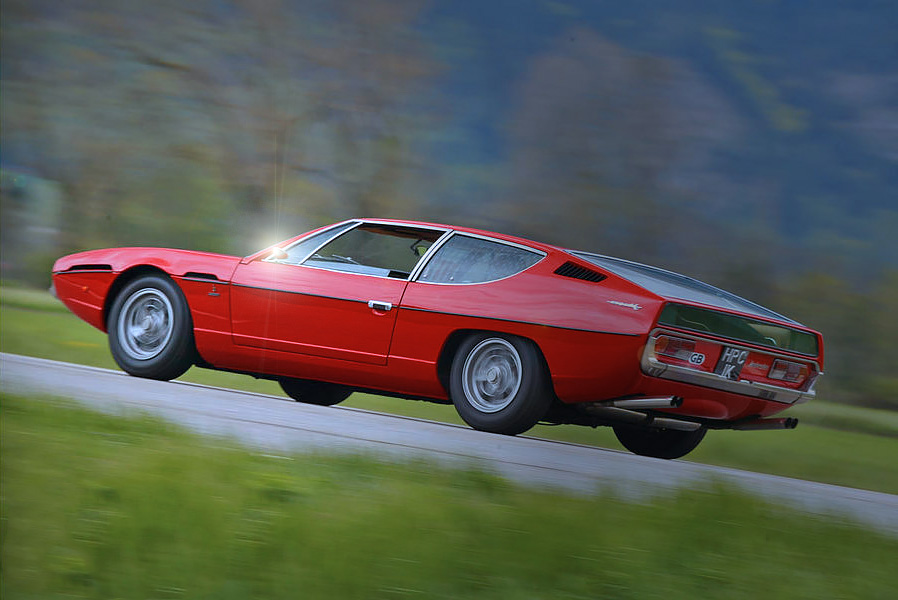
Marzal show car forecast Espada shape. Large cargo area unusual for an exotic. Jaguar-based Piranha had smooth style. Rear louvers neatly hide fuel filler.
Our test car is a 1975 Series III, owned by Italian car enthusiast Tom Haas. The leather-swaddled cabin is a feast for the senses; the buckets are firm and have just enough side bolstering to hold occupants snugly in place. One might wonder just how well the thin padding will stave off posterior discomfort on a long sojourn, but Tom says he’s logged quite a few trips of some duration without soreness or fatigue. In many respects, these seats are very similar to those found in a 1973 Pontiac Firebird Formula — there’s no seatback recline adjustment, and the angle of the backrests and their height are nearly identical — but the Lamborghini offers a few more inches of fore/aft travel, which makes room for a wider height range of drivers.
Once situated, the driver gets the impression of being nestled into a cockpit. The leather steering wheel feels large in diameter, and it is thicker than its famed Nardi wood counterpart; but this suits the intent of the car, as one’s fingers easily wrap around the rim. It has just enough padding to eliminate any vibration transmitted through the chassis. Surprisingly, the car doesn’t force the traditional splayed “Italian” driving position of other Lamborghini and Ferrari road cars; the driver can position himself so he doesn’t have to stretch for the controls, and his elbows can rest at a comfortable 90-degree angle.
The passenger is treated to an adjustable footrest, and the driver gets a dead pedal. With the accelerator set forward of the brake, I can truly heel and toe during downshifts, rather than having to roll my right foot off the brake and into the gas as in modern pedal arrangements. In the rear, passengers sit low to the floor, but with plenty of room for two small adults. Even luggage space is ample.
Visibility over the long hood is good. The broad expanse of flat sheet metal looks familiar to drivers of 1971-1973 Mustangs and 1969-1970 Shelbys, especially with the two NACA ducts. Rearward visibility is likewise excellent because the lower glass allows better judgment of bumper distance than anything I’ve ever reversed in.
The shifter is perfectly positioned, although its gate is hidden by a boot, unlike the pleasingly exposed chrome version in a Ferrari. The shifting mechanism is a bit notchy and given to grinding in second gear when cold, but the heavy mechanical feel is wonderful. The Espada’s clutch is heavy with a short travel, and it makes smooth shifting and management of the revs important things to focus on.
A whine from the gearbox is the most audible noise as I pull away from a standstill. The lovely sound of the chain-driven cams can be heard at about 2,500 rpm in first and second gears, but it is not as overwhelming as the experience in a mid-engine Miura where the firewall is the only thing separating the driver’s ears from the transverse-mounted V12. Selecting third gear in the lower rpm range brings a deeper tone through the exhaust, a muted bass sound that masks the busy action of 24 valves going about their business. By running this master-piece of mechanical engineering past 3,500 rpm, I tap into the sweet spot of the V12’s powerband, and a sonorous combination of mechanical clatter and rising exhaust tones pulses through the cabin; experiencing this, it isn’t foreign to realize that this is a true 150-mph car. Though it will run up to 7,200 rpm before hitting the redline, I force myself to stay in the lower rev range due to the car’s old tires and the cold, slick roads.
This is not a machine designed to sprint from a stop like a runner in a 50-yard dash. Hard acceleration does yield a quick getaway of 0-60 mph in under 7 seconds, but with its tall gearing and V12 engine, the Espada is more suited to making long runs in elegant style. Its flexibility allows the driver to drop into third gear to pass slower traffic with a howl or lug about in fifth without any strain, still leaving reserves of torque to flatten demanding inclines.
The handling follows suit. The modest ratio of the power-assisted steering and large steering wheel is well suited to long sweeping highway curves. The Espada tracks very precisely, perhaps more so than most modern cars. Hands off the wheel and there isn’t a hint of wander, no dead spot at center (unlike many contemporary cars), and it possesses none of the vagueness found in over-boosted systems. The 3.8 turns-to-lock won’t allow razor-sharp cornering, but precise turn-in and generally excel-lent feel with just enough effort make changing lanes and carving exit ramps a pleasure. Despite its seemingly massive proportions, the Espada doesn’t feel heavy at all.
{gallery}Lamborghini-Espada{/gallery}
NACA ducts feed air to HVAC system. The disc brakes are a touch heavy and unresponsive when cold, but begin to liven up once warmed. It is readily apparent that modern brakes with ABS are not underfoot, and this car requires careful thought as to spacing and stopping distances compared to other cars on the road today.
Perhaps the car’s most surprising aspect is the suspension’s performance. One would expect that this machine, built for those seeking the epitome of comfort and style in a grand touring car, would possess a cottony soft ride to absorb every bump while compromising lateral stability. Instead, the Espada feels taut, with firm rebound control of spring motions. It traverses bigger bumps and railroad crossings in a concerted rise and fast settle of front and rear at once, with-out purposing, pitching or excessive travel — just tight, quick response with feedback from the road surface. Likewise, it stays flat while turning in sports car fashion, even though it may not negotiate the corners as quickly or tightly as its two-seat brethren.
‘Viewed in a modem context, it remains uniquely bullish, with its brutal-yet- purposeful looks, screaming V12 engine and practical passenger capacity.’
Sadly, it was late, the weather was so dreary, and the test drive was far shorter than I’d like. On the drive back up New Jersey’s 1-287, I followed Tom as he headed home, shadowing the white Espada as it snaked through traffic. It looked more at ease than anything else around it under the streetlights on that concrete ribbon. Just listening to the crisp V12’s song as he downshifted and peeled off the exit ramp gave me a shiver.
Although the potential customer base for such a high-end car was undoubtedly limited, Lamborghini had a good deal of competition in the 2+2 GT market. When this Espada was new, Ferrari was selling their sharp 365 GT4/2+2, with its 320bhp 4,390cc V12, for $27,900. Aston Martin offered the AM V8 for $22,000, which didn’t have 12-cylinder panache but countered with its 5,340cc four-cam V8 and 350bhp. Not to be left out, Maserati brought their Khamsin to this lofty realm, a $32,975 supercar with a 4,930cc, 315bhp V8.
If you are lucky enough to find one, a nice Espada costs roughly the same today as it did when new (about $20,000-28,000); it’s almost unbelievable that you can now pick up a Lamborghini for the price of a new Ford Mustang. Although the Espada will never be as dependable, efficient or accommodating as a Mustang, that’s beside the point; viewed in a modern context, it remains uniquely bullish, with its brutal-yet-purposeful looks, screaming V12 engine and practical passenger capacity. With their Italian charm, capacity and performance, Espadas are contradictions on wheels — but can you think of a more exciting way to drive in rare style?
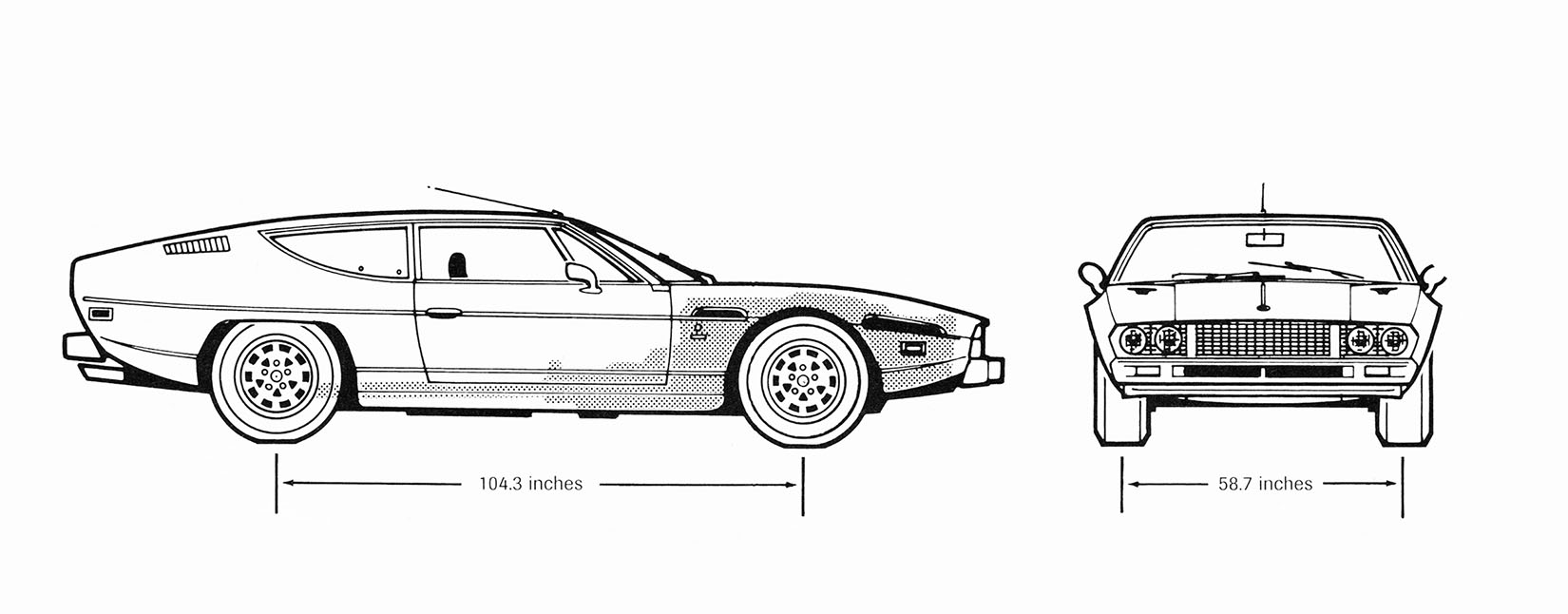
Illustrations by Russell von Sauers, The Graphic Automobile Studio
| Car | 1975 Lamborghini Espada Series III |
| Made in | Italy |
| Sold/number built | 1968-1978 / 1217 (all series) |
| Standard Equipment | Power windows, power steering and brakes, air conditioning, Concord stereo with cassette, two rear speakers |
| Construction |
Frame: Unit steel platform chassis Body constructions: steel body with aluminum hood Body style: four-passenger, two-door GT with rear hatch Layout: Front-engine/rear-wheel drive |
| Dimensions | |
| Wheelbase | 2,650 mm (104.3 in) |
| Overall width | 1,860 mm (73.2 in) |
| Front track | 58.7in |
| Rear track | 58.7in |
| Ground clearance (unladen) | 5in |
| Front headroom (seat uncompressed) | – |
| Rear headroom (seat uncompressed) | – |
| Front legroom (seat forward/back) | 491 square inches |
| Overall length | 4,730 mm (186.2 in) |
| Overall height (unladen) | 1,185 mm (46.7 in) |
| Front shoulder room | – |
| Rear shoulder room | – |
| Rear legroom (seat forward/back) | – |
| Mechanical Specification | |
| Weight (in lbs kerb) |
1,465 kg (3,230 lb) |
| Steering | ZF, worm and screw, power assist |
| Ratio | 18.3:1 |
| Turning circle |
39.3 feet |
| Turns (lock to lock) |
3.8 |
| Brakes |
4-wheel Girling vented discs with power assist Dimensions, front 11.8 inches, rear 11.0 inches. Total swept area 491 square inches |
| Engine | |
| Material | Light alloy 60-degree V12 |
| Main bearings (number) |
7 |
| Cooling system |
Water, Pressurized, vertical-flow radiator with two thermostatically controlled electric fans |
| Valve gear layout | dohc-per-bank |
| Ignition | Marelli capacitor discharge |
| Carburettors/injections |
6 sidedraft twin-throat Weber 40 DCOE 20-21 carbs, electric fuel pump |
| Compression ratio |
10.7:1 |
| Capacity (cc) | 3,939cc |
| Bore (mm) |
82 |
| Stroke (mm) |
62 |
| Power (net bhp/rpm) |
350bhp at 7000rpm |
| Torque (net lb ft/rpm) |
290lb/ft at 4500rpm |
| Transmission | |
| Gearbox |
ZF five-speed maual all synchromesh |
| Top gear mph per 1000rpm | 19 |
| Ratios: |
1st – 2.52:1 2nd – 1.74:1 3rd – 1.23:1 4th – 1.00:1 5th – 0.82:1
Reverse – 2.86:1
|
| Final drive ratio |
4.50:1 |
| Clutch : Make: |
ZF
Type: Single dry plate Diameter: 10.5 inches Actuation: Hydraulically operated |
| Type |
Single dry plate |
| Differential |
Type: ZF, Hypoid Ratio: 4.04:1 |
| Wheels and Tyres | |
| Wheels (type and size) | Campagnolo, cast magnesium alloy, 15×7 inches |
| Tyres (type and size) | Pirelli P5, 215/70 VR-15 |
| Replenishment & Lubrication | |
| Type of oil | 10W/40 |
| Engine sump capacity | – |
| Engine oil change interval (miles) | 9.000 |
| Gearbox and final drive capacity | – |
| Type |
– |
| Gearbox capacity | – |
| Final drive capacity |
– |
| Type | – |
| Lighting | |
| Number of lights | 6 |
| Type |
Halogen |
| Battery (make) | Bosch |
| Voltage |
12V |
| Suspension | |
| Front |
Independent, unequal length А-arms, coil springs, Koni shocks, anti-roll bar |
| Rear |
Independent, unequal length А-arms, coil springs, Koni shocks, anti-roll bar |
| Braking (Actual stopping distance in feet) | |
| 30mph | – |
| 70mph | – |
| Fuel consumption | |
| Overall (mpg) |
10.8 |
| Driven carefully (mpg) | 13 |
| Star rating | 3 |
| Range |
– |
| Tank capacity |
20.6 gallons |
| Performance | |
| From standstill to mph. in seconds | |
| 0-30 | 2.9 |
| 0-45 | 4.5 |
| 0-62 | 6.5 |
| 0-75 | 10.9 |
| Max speed | 158mph (max speed in test) |
| Price new (1975, USA) | $33,900 |
| Cost new (1975, GB) | £15,485 |
| Value now (2014, USA) | Low $13,900, Average $23,900, High $29,500 |
Owner’s view By Mark J. McCourt.
It is doubtful that Lamborghini would have chosen to market their long-running Espada series as family sports cars, but this is how owner Tom Haas feels about his 1975 Series III. “I have two children, and my family spends a lot of time together,” he says. “I’m not the type to go off on my own without them just to drive, so the Espada makes perfect sense. When they were younger, I actually used to put a child seat in the back!”
Tom hasn’t had to do much to his 35,000-mile beauty. “I did have the pin striping removed, and I found original wheels to replace the aftermarket wires that were on it when I bought it,” he says. He admits that the Espada is very expensive to maintain, and finding parts for these hand-built cars can be difficult. “It’s very labor-intensive if something big breaks,” Tom says, “but Lamborghini is very accommodating to their owners and clubs, and the factory is very helpful with information, parts, and even a restoration service. I met Lamborghini’s chief test driver, Valentino Balboni, at a club meet here in the States, and when he returned to Italy, he literally walked back into the factory’s storage and found a luggage cover to replace my car’s missing one; it’s not like dealing with GM.”
So does it perform? “I’ve driven several times on Pocono International Raceway’s road course, and it held its own,” Tom laughs. “It does well for being the Italian version of a Rolls Royce limousine.”
|
Pros and cons |
Clubs USA |
Parts prices |
|
Pros Affordable high-end sports car for four Distinctively sleek exotic Italian styling Great sounding overhead cam V12 power |
Lamborghini Owners Club P.O. Box 7214 St. Petersburg, Florida 33734 727-392-3474 Dues: $25/year; membership: 1,100 |
Clutch disc $457 Exhaust header gasket (6 required) $10 each Fender emblem $98 Rear brake rotor $827 |
|
Cons Body and trim parts are very expensive Engine rebuild requires a second mortgage There are six-count ’em six-carbs tune |
Lamborghini Club P.O. Box 649 Orinda, California 94563 925-253-9399 Dues: $60/year; membership: 1,800 |
Right front fender assembly (includes hood) $5,567 Muffler assembly (2 required) $918 each Windshield glass $3,650 |





